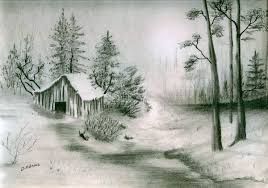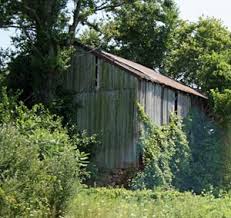Source:Google.com.pk
Pencil Drawings Of Barns Biography
Here's a brief biographical sketch:
Steven Kozar was born in 1964 in Illinois, where he lived until moving to Wisconsin in 1986. He grew up in Lake Zurich, IL, a small town approximately 35 miles northwest of Chicago. His parents moved to Lake Zurich from Chicago right before he was born. Although he lived on the edge of farm country, he had no history of rural or agricultural living in his family.
“One of my favorite childhood memories is feeding grass to the cows that lived on the farm down the street. We had a large field (with a nearby creek) across the street and a wooded area behind us.”
For as long as he remembers, he was always busy drawing. By the fifth grade his drawings could have passed for high school work, and he won various awards along the way.
His interest in architecture and Frank Lloyd Wright caused him to draw detailed images from the books he repeatedly checked out of the local library. The modern American sculptor/artist Alexander Calder was also a big favorite. Kozar spent hours in the basement with a blowtorch making mobiles (hanging sculptures) out of thin sheet metal and wire.
“I felt driven to create things. A perfect day for me would have been to be left alone with a gigantic pile of junk so I could make something out of it.”
Around the same time (fifth or sixth grade) he became familiar with the painting of Andrew Wyeth. As a youngster, Kozar enjoyed staring out the car window at the repeating rows of corn in the surrounding countryside, and he was especially fond of the rolling farmland in nearby Wisconsin. Seeing Wyeth’s work instilled a deeper love of the rural landscape in him, as well as an interest in watercolor. A high school art teacher prompted him to copy a Wyeth painting in watercolor, and within a few hours he painted an amazing duplicate. His relationship to watercolor was cemented on that day.
“My art teacher, Bill Weber, told me that I could make a living as an artist/illustrator when he saw what I did. I remember being very excited about it.”
In high school, Kozar experienced his parents’ divorce at an already difficult time in his young life. After having just begun getting into trouble with the wrong crowd he was invited to a “Campus Life” club in his town- a non-denominational ministry of Youth for Christ. Along with providing a deep and lasting spiritual foundation for him, the group spent extensive time camping, rock climbing, canoeing, and bicycling in Wisconsin. Kozar's love of the rolling farmland of Wisconsin was permanently cemented at that time.
“I’m thankful that my best teenage memories involve time spent in the beauty and quietude of the outdoors, talking and thinking about the really important matters of life.”
Kozar was also becoming attached to Paulette Steinke during that same time. They had known each other since kindergarten and began dating at age fourteen. While the teenage Kozar tried to decide what to do with his life, Paulette was already dreaming of marrying him and helping him to become a great artist.
As a somewhat anti-establishment teenager, Kozar was bored with much of high school and had marginal interest in college. After high school he began work as a construction worker taking apart old barns. After a year and a half of low-paying physical labor, he was given the task of making a pencil drawing of the barn framework as a guide to re-build the structure elsewhere. Sitting in a field drawing while his workmates swung sledgehammers gave Kozar a very profound thought;
“I should be using my God-given talent for art instead of spending my life doing construction work!”
He enrolled at Illinois State University for the simple reason that some friends went there. He enjoyed studying European History and Art History (as well as Music Theory) but was dissatisfied with the lack of disciplined training going on at the time. Ironically, as an underclassman he never met or studied with Harold Gregor during his brief time there. Gregor is considered the “dean “ of Midwestern realism landscape painters, and since then, Kozar and he have exhibited together on occasion.
“My time at the University was helpful because I gained a broader perspective on art and its place in history. It was also a difficult time because what I was interested in-drawing and painting realistically-was looked down upon by many of my teachers.”
Kozar left I.S.U. after only a year and a half to attend classes at the American Academy of Art in Chicago. The Academy was a small private art school still teaching some of the old principles of drawing and painting that had been discarded by much of academia. When Kozar saw examples of student work, he knew he’d found a place that could teach him what he really wanted to learn-how to draw and paint.
“We didn’t look at pictures of art in books-we did it. All day long, five days a week, all we did was draw and paint. I was like a starving man who just stepped into an all-you-can-eat buffet!”
Because Kozar was always the best in whatever art class he took, he never felt very challenged in school-until he found himself in Life-Drawing 101 at the American Academy of Art. Two things caused him to accelerate and grow his skills very quickly at the art school; one, he saw students that could draw and paint better than him, which brought out a more competitive side to his usually laid-back personality. And two, he was a twenty-one year old newlywed trying to “get good” in a hurry so he could support a wife and, eventually, a family.
Living in a tiny studio apartment in downtown Chicago, Kozar vowed to Paulette that he’d be a nationally known artist in five years. In the isolation of that cramped apartment, he worked constantly at improving his skills. When not in class he was visiting the Art Institute of Chicago, or reading about art and artists at the Chicago Public Library. Even at an art school full of art students his classmates would say “is that all you talk about-art?!”








Pencil Drawings Of Barns Biography
Here's a brief biographical sketch:
Steven Kozar was born in 1964 in Illinois, where he lived until moving to Wisconsin in 1986. He grew up in Lake Zurich, IL, a small town approximately 35 miles northwest of Chicago. His parents moved to Lake Zurich from Chicago right before he was born. Although he lived on the edge of farm country, he had no history of rural or agricultural living in his family.
“One of my favorite childhood memories is feeding grass to the cows that lived on the farm down the street. We had a large field (with a nearby creek) across the street and a wooded area behind us.”
For as long as he remembers, he was always busy drawing. By the fifth grade his drawings could have passed for high school work, and he won various awards along the way.
His interest in architecture and Frank Lloyd Wright caused him to draw detailed images from the books he repeatedly checked out of the local library. The modern American sculptor/artist Alexander Calder was also a big favorite. Kozar spent hours in the basement with a blowtorch making mobiles (hanging sculptures) out of thin sheet metal and wire.
“I felt driven to create things. A perfect day for me would have been to be left alone with a gigantic pile of junk so I could make something out of it.”
Around the same time (fifth or sixth grade) he became familiar with the painting of Andrew Wyeth. As a youngster, Kozar enjoyed staring out the car window at the repeating rows of corn in the surrounding countryside, and he was especially fond of the rolling farmland in nearby Wisconsin. Seeing Wyeth’s work instilled a deeper love of the rural landscape in him, as well as an interest in watercolor. A high school art teacher prompted him to copy a Wyeth painting in watercolor, and within a few hours he painted an amazing duplicate. His relationship to watercolor was cemented on that day.
“My art teacher, Bill Weber, told me that I could make a living as an artist/illustrator when he saw what I did. I remember being very excited about it.”
In high school, Kozar experienced his parents’ divorce at an already difficult time in his young life. After having just begun getting into trouble with the wrong crowd he was invited to a “Campus Life” club in his town- a non-denominational ministry of Youth for Christ. Along with providing a deep and lasting spiritual foundation for him, the group spent extensive time camping, rock climbing, canoeing, and bicycling in Wisconsin. Kozar's love of the rolling farmland of Wisconsin was permanently cemented at that time.
“I’m thankful that my best teenage memories involve time spent in the beauty and quietude of the outdoors, talking and thinking about the really important matters of life.”
Kozar was also becoming attached to Paulette Steinke during that same time. They had known each other since kindergarten and began dating at age fourteen. While the teenage Kozar tried to decide what to do with his life, Paulette was already dreaming of marrying him and helping him to become a great artist.
As a somewhat anti-establishment teenager, Kozar was bored with much of high school and had marginal interest in college. After high school he began work as a construction worker taking apart old barns. After a year and a half of low-paying physical labor, he was given the task of making a pencil drawing of the barn framework as a guide to re-build the structure elsewhere. Sitting in a field drawing while his workmates swung sledgehammers gave Kozar a very profound thought;
“I should be using my God-given talent for art instead of spending my life doing construction work!”
He enrolled at Illinois State University for the simple reason that some friends went there. He enjoyed studying European History and Art History (as well as Music Theory) but was dissatisfied with the lack of disciplined training going on at the time. Ironically, as an underclassman he never met or studied with Harold Gregor during his brief time there. Gregor is considered the “dean “ of Midwestern realism landscape painters, and since then, Kozar and he have exhibited together on occasion.
“My time at the University was helpful because I gained a broader perspective on art and its place in history. It was also a difficult time because what I was interested in-drawing and painting realistically-was looked down upon by many of my teachers.”
Kozar left I.S.U. after only a year and a half to attend classes at the American Academy of Art in Chicago. The Academy was a small private art school still teaching some of the old principles of drawing and painting that had been discarded by much of academia. When Kozar saw examples of student work, he knew he’d found a place that could teach him what he really wanted to learn-how to draw and paint.
“We didn’t look at pictures of art in books-we did it. All day long, five days a week, all we did was draw and paint. I was like a starving man who just stepped into an all-you-can-eat buffet!”
Because Kozar was always the best in whatever art class he took, he never felt very challenged in school-until he found himself in Life-Drawing 101 at the American Academy of Art. Two things caused him to accelerate and grow his skills very quickly at the art school; one, he saw students that could draw and paint better than him, which brought out a more competitive side to his usually laid-back personality. And two, he was a twenty-one year old newlywed trying to “get good” in a hurry so he could support a wife and, eventually, a family.
Living in a tiny studio apartment in downtown Chicago, Kozar vowed to Paulette that he’d be a nationally known artist in five years. In the isolation of that cramped apartment, he worked constantly at improving his skills. When not in class he was visiting the Art Institute of Chicago, or reading about art and artists at the Chicago Public Library. Even at an art school full of art students his classmates would say “is that all you talk about-art?!”
Pencil Drawings Of Barns

Pencil Drawings Of Barns

Pencil Drawings Of Barns
Pencil Drawings Of Barns
Pencil Drawings Of Barns
Pencil Drawings Of Barns
Pencil Drawings Of Barns
Pencil Drawings Of Barns
Pencil Drawings Of Barns
How To Draw A Barn Owl
How To Draw An Old Barn
No comments:
Post a Comment